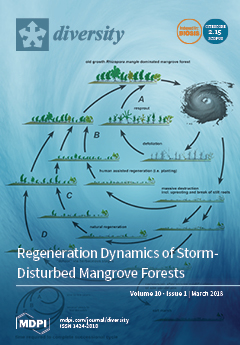We evaluated the phenological response and litterfall production of
Rhizophora mangle to changes in pore water chemistry over a five-year period (from 2009 to 2014 and 2010 to 2016) along the coast of Campeche, México. Severe drought conditions were recorded in 2009 with
[...] Read more.
We evaluated the phenological response and litterfall production of
Rhizophora mangle to changes in pore water chemistry over a five-year period (from 2009 to 2014 and 2010 to 2016) along the coast of Campeche, México. Severe drought conditions were recorded in 2009 with a Standardized Precipitation Index (SPI) of −1.5 and again in 2015 with a SPI of −1.16). A precipitation deficit of 22.1% was recorded between 2009 and 2016 ranging from 9.5% in Laguna de Terminos in the south to 64.4% in Los Petenes Biosphere Reserve in the north. Precipitation varied significantly per year (
p < 0.001), seasonally (
p < 0.001), and between years and seasons (
p < 0.001). An interaction was observed in the salinity (
p < 0.05), redox potential (
p < 0.001), and precipitation (
p < 0.001) of the Laguna de Terminos, Rio Champoton, and Los Petenes Biosphere Reserve regions. Significant differences were found between the years in the leaf and propagule production (
p < 0.001), and between seasons in production of leaves, flowers, and propagules (
p < 0.001). The determining factor in the production of flowers during both the rainy and dry seasons was the salinity, and the determining factors for the production of propagules were the redox potential and salinity. The results of this study suggest a low phenotypic plasticity in
R. mangle.
Full article





